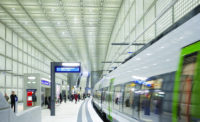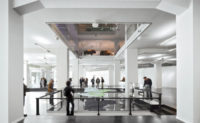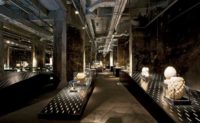Bendorf, Germany
Bendorf, a Rhine River city north of Koblenz, Germany, and a former center of mining and ironwork, acquired the derelict Sayn Iron Works Foundry in 2004 to repurpose it as a cultural attraction and an event space. A cutting-edge industrial building celebrated for its inventive design when it was built in 1830, the intricate structure is now illuminated by sensitively integrated LEDs that allow for contemporary use and lend an enchanting nocturnal appeal. “We wanted to use modern technology to bring the old foundry back to life,” says Werner Prümm, who oversees the city’s economic development.
Designed by architect Carl Ludwig Althans, the building, which is situated on a site hugging a wooded slope on the city’s outskirts, is a basilica-like hall with massive masonry walls. In order to flood the capacious interior with daylight, Althans installed clerestories above the central nave, fenestration along the sides, and spectacular glazing with neo-Gothic tracery on the west-facing facade. Details are both eclectic—including 20-foot-high columns topped with Doric capitals and prefabricated cast-iron structural framework devoid of rivets and screws—and functional, like the elevated tracks to transport materials flanking the central nave and the three giant pivoting cranes attached to the columns.
Following an overall renovation in 2014, the city commissioned the Bonn-based lighting-design firm Licht Kunst Licht (LKL) to develop a scheme for the newly restored foundry, now a listed building. The designers were required to preserve the physical substance and devise a no-frills yet versatile design that maintains the landmark’s distinct character and can accommodate diverse functions. “The concept was spare and elegant,” says designer Johannes Roloff.
First, LKL convinced the officials to abandon using exterior illumination to draw attention to the monument at night and to replace it with more evocative interior lighting. “We wanted a building that pours warm light out into the surroundings,” says Roloff, “and seems to glow from within.”
To accomplish this, the design team felt it was necessary to clearly articulate the continuous interior surfaces. Concealed adjustable linear RGB LED strips bathe the underside of the roof in the nave in alternating white or brilliant red tones. Washers at the base of the rear wall uplight this surface, and the sidewalls receive indirect illumination from spotlights affixed to two elevated tracks, which transverse the hall above the columns.
Then the designers turned to the industrial artifacts and historic construction within. The cast iron elements had been coated with a special paint containing glimmering metal flakes. To emphasize this effect, LED spotlights with a cool 4000K color temperature and a narrow angle were mounted at the top of the columns and aimed at each member along the side aisles. For those in the nave, spotlights were placed underneath the elevated tracks. Each giant crane received two spotlights, placed at different angles to enliven them and cast shadows on the surrounding floor.
Because the space will house receptions, exhibitions, and performances, adjustable LED spotlights, also positioned on the elevated tracks, are equipped with honeycomb louvers or snoots to reduce glare and direct strong, warm-white 2700K downlight to the base of the building. LED luminaires were employed throughout to minimize cost and energy, as well as to provide the ability to alter color schemes via a digital DALI lighting-control system that is equipped with a DMX interface. Most of the luminaires have casings that blend in with the historic construction to conceal them.
Lead designer Johannes Roloff worked in theatrical lighting for a decade before turning to architecture, and it is not surprising that his schemes for the Sayn Iron Works Foundry have dramatic flair—the white ceiling illumination possesses an ethereal demeanor, while the red tones conjure up visions of the smoldering furnaces and molten iron that once occupied this space. Both hint at the inner life of this restored landmark, but their means do not overwhelm it. “Licht Kunst Licht understood it was important to put the architecture in the foreground,” says Werner Prümm, “and not show off their own special effects.”
PeopleLighting Designer:
Photographers: Johannes Roloff, Thomas Naethe
|
ProductsLighting Guzzini, EWO, GE (fixtures); Jung (control interface) Interior ambient lighting Linear profile luminaire, wallwashing light distribution, RGB, LED Dimming system or other lighting controls DALI-DMX interface with touchpanel front-end |












Post a comment to this article
Report Abusive Comment